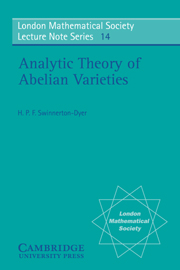Chapter I - Background
Published online by Cambridge University Press: 05 April 2013
Summary
Compact Riemann surfaces and algebraic curves
A Riemann surface is a topological space which in a neighbourhood of any point looks like the complex plane. (Some writers also require a Riemann surface to be connected.) More precisely, a Riemann surface is a Hausdorff space S which is endowed with a complex one-dimensional structure in the following way. For each point P of S we are given an open neighbourhood N of P and a homeomorphism ϕ from N to a disc |z – ϕ(P) | < c in the complex z-plane for some c > 0. These homeomorphisms satisfy the following consistency condition. Let P1, P2 be any two points of S such that their corresponding neighbourhoods N1, N2 overlap; then ϕ1 º ϕ−12 is holomorphic on ϕ2(N1 ∩ N2). If f(z) is a function which is holomorphic and has non-zero derivative at z = ϕ(P), then we can replace ϕ by f º ϕ (with corresponding changes in N and c) without changing the complex structure of S. We call ϕ a local variable at P; clearly it is then a local variable at each point of N.
We can now transfer all the standard terminology of the theory of functions of a complex variable from the complex plane to Riemann surfaces. For example, a function ψ defined in a neighbourhood of P is holomorphic at P if ψ º ϕ−1 is holomorphic at z = ϕ(P), where ϕ is a local variable at P; the consistency condition is just what is needed to ensure that ψ is then holomorphic in a neighbourhood of P.
- Type
- Chapter
- Information
- Analytic Theory of Abelian Varieties , pp. 1 - 28Publisher: Cambridge University PressPrint publication year: 1974

